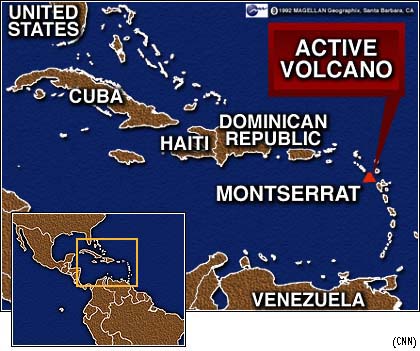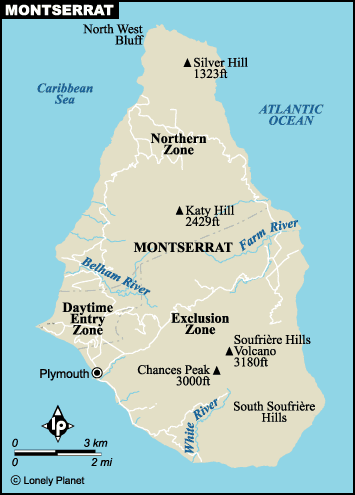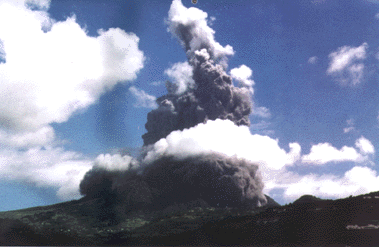Montserrat
Emergency Medical Services
Project
My wife, Faith & I have begun work on bringing Emergency Medical System (EMS) training to the devastated Caribbean island of Montserrat. Faith is an Emergency Medicine Physician and I am an American Heart Association Basic Life Support Instructor Trainer along with being the President of Sterling Volunteer Rescue Squad in Virginia.
This is our project:



Trip No. 1: From 02-12 December 2002, Dr. Faith Dillard, George Washington University Hospital Emergency Medicine Resident, myself (PJ Azzolina, Basic Life Support Instructor Trainer) along with Jennifer Lee Jenkins, a GW medical student, will embark upon a humanitarian trip to the West Indies island of Montserrat as guests of the Chief Medical Officer, Dr. Joseph Hawes. Under the auspices and generous donations from the Champion Foundation, the Ronald Reagan Institute for Emergency Medicine, Sterling (Virginia) Volunteer Rescue Squad, The MITRE Corporation, the American College of Emergency Physicians (ACEP), INOVA Fairfax Hospital and Physio Control, we will be helping the medical needs of the remaining inhabitants of this beautiful island.
Our plan is to establish an annual visit so that we can maintain a growing program of Basic and Advanced Life Support training to Montserratians. Our first trip this December we will be bringing a number CPR manikins, a defibrillator and a heart monitor and performing training in the use of the equipment. We will be able to leave behind the defibrillator and heart monitor and hope that subsequent trips we will be able to get permanent CPR manikins for the island.
Trip No. 2: From 12 July 2003,
Trip No. 3: From 29 November-08 December 2003.
Trip No. 4: From 9-21 July 2004, Dr. Faith Dillard, Emergency Medicine Attending and myself (PJ
FUNDING: The need.
Our biggest obstacle is funding. Shipping equipment, transportation, housing, and administration of this program is beyond our personal means and can only occur with the generous donations from numerous foundations, corporations and individuals. We need your help. If you are a medical corporation and can donate equipment, a foundation or individual who can donate funding please contact us at: PJ Azzolina.
Thank you.
PJ Azzolina, BLS Instructor Trainer;
Faith Dillard, MD; and
J. Lee Jenkins, MD
ADDITIONAL LINKS:
http://www.geo.mtu.edu/volcanoes/west.indies/soufriere/govt/
http://www.cia.gov/cia/publications/factbook/geos/mh.html
http://www.visitmontserrat.com/
http://www.montserratreporter.org/
http://volcano.und.nodak.edu/vwdocs/current_volcs/montserrat/montserrat.html
Article from Encarta.
Montserrat (island), dependency of the United Kingdom, one of the Leeward Islands of the Lesser Antilles, in the Caribbean Sea. Montserrat is located southwest of Antigua and northwest of Guadeloupe. A governor administers the dependency with the assistance of executive and legislative councils.
The island, 102 sq km (39 sq mi) in area, is mountainous, rising to the peak of the Soufriere Hills volcano (914 m/ 2,999 ft). After centuries of lying dormant, the Soufriere Hills volcano rumbled back into activity in 1995 with minor eruptions that continued through 1996. The volcano erupted violently on several occasions in 1997, killing 19 people in June and pelting the southern portion of Montserrat with fiery gas, rocks, and ash on a number of occasions.
The main economic activity on Montserrat is farming. Principal agricultural products include tomatoes, white potatoes, onions, carrots, limes, and cotton. Manufactures include electronic equipment, metal and plastic goods, linen, and clothing. The volcanic eruptions in 1997 devastated the island’s economy. The British government sent financial aid and provided supplies to build housing for the remaining population.
The island was sighted by Christopher Columbus in 1493 and was named by him for a noted monastery on Montserrat, a mountain in Spain. Settled by the English and Irish in 1632, the island was held by the French for four years in the 1660s and again from 1782 to 1783, when it came under definitive British control. From 1871 to 1956 Montserrat was part of the Federation of the Leeward Islands, and in 1958 it became a member of the Federation of the West Indies. Following the dissolution of the federation in 1962, the inhabitants of the island voted to remain a dependency of Great Britain. Hurricane Hugo devastated the island in 1989.
In 1995 Soufriere Hills volcano began exhibiting signs of volcanic activity. Residents were evacuated several times from the southern third of the island, which includes the capital of Plymouth. Minor eruptions in 1996 forced a final evacuation of the area. A series of major eruptions caused serious damage during the second half of 1997. Nineteen people were killed following a June 25 eruption. In August an eruption destroyed Plymouth (population, 1995 estimate, 3,500), the island’s capital and only major community. A pyroclastic flow (a stream of heated rock, ash, and gases) set fire to many buildings and further eruptions buried much of the city beneath drifts of ash. In September an eruption destroyed the island’s airport in Olveston after flows of heated gas set fire to the complex.
The southern region of the island remained uninhabited into 1999 as volcanic activity continued. Most of the island’s population of 12,771 (1996 estimate) evacuated to neighboring islands. The remaining residents, numbering about 4,000, took refuge on the northern edge of the island, which is sheltered from the volcano by a range of hills. In early 1999 scientists announced that the eruption may have exposed island residents to harmful levels of cristobalite, a fine mineral which can cause lung disease.
Microsoft® Encarta® Reference Library 2002. © 1993-2001 Microsoft Corporation. All rights reserved.